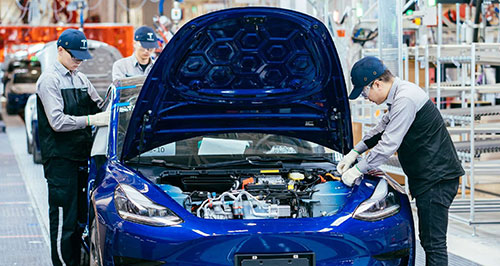Make / Model Search
News - TeslaTesla returns to profitLudicrous mode: Tesla has completed construction of its Shanghai Gigafactory in just 10 months, less time than it often takes to build a suburban home. Shanghai factory, Model Y ahead of schedule as Tesla seeks production site in Europe25 Oct 2019 TESLA returned to profit during the third quarter of this year, for once over-delivering on a forecast by CEO Elon Musk, who predicted the company would break even during Q3 and turn a profit by year’s end.
Having cut costs, ramped up production of the Model 3 mid-size sedan and improved gross margins, Tesla delivered a net profit of $US143 million ($A209.8m). The company’s stock price surged more than 20 per cent following the news, reaching more than $US300 for the first time since March.
Free cash flow of $US371m helped shore up a $US5.3b war chest in preparation for the next phase of growth, which will include establishing a new factory in Europe – the location of which Mr Musk said will be announced before the end of this year.
In an earnings call with investors on Thursday, he said Tesla’s operating cost was “now at the lowest level since Model 3 production started”.
Tesla chief financial officer Zachary Kirkhorn added that the company had “exited the quarter with our highest quarter-ending cash balance ever”.
It also produced the highest number of vehicles to date, at 96,000 units, with 97,000 delivered.
The company’s Shanghai factory has been completed ahead of schedule and is already building trial Model 3 batches before ramping up to mass-produce lower-spec variants for sale in greater China, which Tesla expects to become its largest market for the Model 3.
Meanwhile, Tesla is fast-tracking the Model Y mid-size SUV, which Mr Musk said is now expected to launch in the northern hemisphere summer, rather than autumn as originally anticipated.
He also predicted the Model Y would “outsell Model S, Model X and Model 3 combined” and cast doubt over the future of Tesla’s two larger, more expensive models by describing them as “of minor importance to the future”.
“To be totally frank, we're continuing to make them more for sentimental reasons than anything else,” said Mr Musk.
Mr Kirkhorn said average selling prices of the Model Y would be higher than the Model 3 on which it is based, but that the SUV would be more profitable as it is expected to cost around the same to produce as the sedan.
“As it stabilises with steady state production, we do expect that (Model Y) will be a higher-margin product,” he said. “It's something that we're very excited about within the company.”
Mr Kirkhorn also said profit margins on vehicles produced at Shanghai were expected to be “roughly in line” with Fremont.
In its Q3 financial report, Tesla stated that the Shanghai factory cost around 65 per cent less to build per unit of capacity than its Model 3 line in the United States.
The reason for the comparable margin may have been alluded to by Mr Musk on Twitter in January, when he said production of lower-cost variants of the Model 3 would take place in Shanghai for the Chinese market, with higher-cost variants continued to be built in the US for worldwide consumption including China.
The Model Y is confirmed to eventually join the Model 3 on Tesla’s Shanghai production line, with both these models also slated to be assembled in Europe.
Before ramping up and ultimately delivering vehicles out of Shanghai, Tesla says it must finalise its manufacturing license with Chinese authorities and satisfy “other governmental requirements”.
“Ultimately having three Gigafactories effectively will triple out our output,” said Mr Musk during this week’s earnings call.
“And then when you consider increased output per Gigafactory, it's going to actually more than triple our output over time.”
In addition to releasing revenue with the roll-out additional autonomous driving capabilities in markets around the world, Mr Musk said Tesla will now place greater focus on untapped potential within the energy side of its business that sells solar panels and battery systems.
Supplying components and licensing technology to other car manufacturers – which Tesla has done with Toyota and Mercedes-Benz in the past – also remains on the table.
“We're definitely open to supplying batteries and powertrains and perhaps other things to other car companies,” said Mr Musk.
“It would be consistent with the mission of Tesla to help other car companies with electric vehicles on the battery and powertrain front, possibly on other fronts.”
He also said he expected demand for new cars to increase with the uptake of electric vehicles, drawing parallels with the transition from cathode ray tube (CRT) televisions to modern flat-screen models.
“You wouldn't really buy a new CRT TV unless yours broke, but when flat screens came out there was a big step change in demand because now getting a big flat-screen TV was much better than having a small CRT TV,” Mr Musk said.
“I think we'll see the same thing with electric vehicles … Instead of people buying a car just because their last car wore out, they'll buy an electric car because they're fundamentally a better car, and especially if it's got self-driving.”  Read more2nd of October 2019  Tesla Model 3 sales dwarf all other EVsMore than 2400 deliveries and counting for Tesla’s Model 3 in Australia since August15th of August 2019  Tesla halves industry-leading warrantyKia warranty benchmark again as Tesla moves back to four-year/80,000km period31st of July 2019  Netflix, YouTube to join Tesla infotainmentMusk says ‘v10’ Tesla software update to introduce in-car Netflix, YouTube streaming31st of July 2019  Tesla co-founder Straubel steps down as CTOEV technology mastermind JB Straubel switches from Tesla CTO role to senior advisor23rd of July 2019  Tesla brings 620km Model 3 Long Range to OzAustralian Tesla Model 3 line-up gains Long Range variant claiming 620km on a charge |
Click to shareTesla articlesResearch Tesla Motor industry news |











Facebook Twitter Instagram